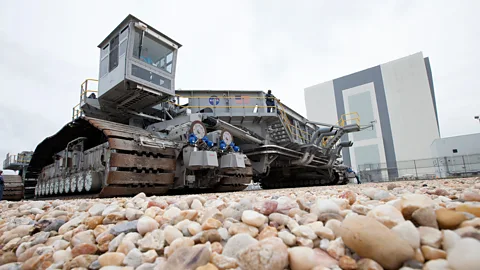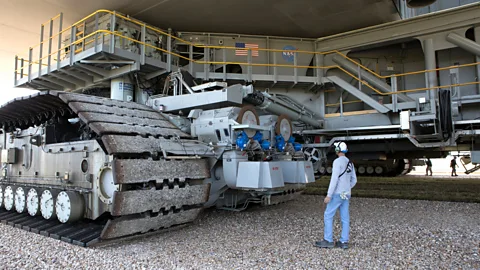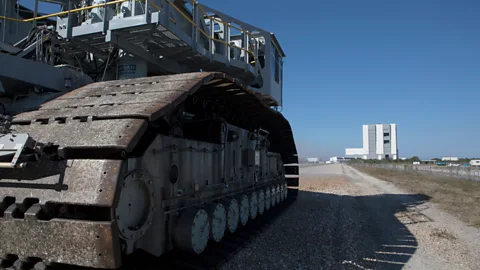Driving one of the world's largest vehicles

 Nasa
NasaWhen Nasa’s giant SLS rocket carries out its first mission, it will be brought to the launchpad by one of the largest vehicles ever built. And driving it requires massive concentration.
Within the next two years, Nasa plans to blast the first of its Space Launch System (SLS) rockets on a 384,400 km (238,855 mile) uncrewed voyage around the Moon. With plans for lunar space stations, Moon bases and Mars missions, the future of America’s state-funded astronaut programme depends on its success.
Although the SLS is brand new, the multi-billion-dollar 98m-tall (322 ft) launcher will begin its journey at the Kennedy Space Center in Florida on a vehicle that is more than 50 years old. And, for the team charged with conveying the rocket the seven kilometres (4.3 miles) to the launchpad, the pressure is on.
“There’s a great sense of pride carrying America’s space programme on your back,” says Bob Myers, one of the elite team of drivers for Nasa’s pair of giant crawler-transporters – among the largest land vehicles ever built. “We have one rocket, we have one shot and we don’t want to mess that shot up.”
You might also like:
The four-tracked crawlers were built in 1965 to carry the Saturn 5 rocket that took astronauts to the Moon. They were adapted in the 70s for the Space Shuttle. Now, one of these has been refurbished and strengthened to convey the SLS. Despite some modernisation, the fundamental design of the 40-metre-long (131 feet), 35 metre-wide (114 feet), 2,700 tonne (six million pound) giant tracked vehicle remains the same.
“We brag sometimes that the crawlers were made with a slide rule and not a computer,” says Myers, who has been driving the crawler-transporters for more than 35 years. “They were built better – overbuilt – than many vehicles today and as a result they’re very reliable.”
 Getty Images
Getty ImagesTheir vital statistics are certainly impressive. The crawlers are powered by two diesel engines which drive generators supplying electricity to 16 traction motors. The tracks in each corner are made up of twin treads with 57 shoes, and a system of sensors and jacks keeps the upper platform – and hence the rocket – level during the journey along the crushed rock roadway and up the ramp to the launch pad. The route from the vehicle assembly building also includes corners, which means the tracks need to pivot.
“We have a team of contractors who prepare the crawler-way every time we’re ready to roll,” says Crawler project manager, John Giles. “As the crawler moves along, it crushes the rock - which flies around as it’s pulverised.”
The machines are controlled from cabs jutting out at the front and back. When Myers first took the controls in 1982 to carry a Space Shuttle to the launch pad, he admits it was a nerve-wracking experience. “I was pretty nervous, when you’re carrying a rocket there’s an obvious sense of power,” he says. “It’s not like driving a Volkswagen.”
“It’s scary at first and if anything goes wrong, it not something we’d want to talk about for a very long time,” Giles adds. “It takes time to get used to the extra pressure and stress.”
Although the driver is supported by a team of observers with radios walking alongside to monitor the crawler’s progress, there are in fact parallels with driving a car. The driver has a tiny six-inch (15cm) diameter steering wheel, speed dial and a brake pedal. All commands from the relatively simple controls are fed into the newly-upgraded computer system to ensure the smooth operation of the hydraulic pumps that activate the 1960s mechanical components.
 Nasa
Nasa“It’s fairly simplistic but it has everything you need,” says Myers. “There are a lot of curves and places to slow down [on the journey] but it’s a matter of experience and use of your observers that help you operate the vehicle.”
Moving a giant rocket isn’t something you can get done before lunch. It takes at least seven hours to complete the journey to the launch pad. The drivers swap every couple of hours along the way but the crawler keeps on going.
“We don’t stop until we’re on top of the pad and have the launcher sat down,” Myers says. “We don’t want to run into weather and that’s why we try to get the operation done as quickly and safely as possible.”
That a machine so vast can move at less than a mile an hour (1.6km/h) is one of the greatest achievements of the original engineers. “It’s not about how fast it can go – it’s about how slow it can go,” says Myers. “It has the capability for positioning and docking its platform on the launch pad to within half an inch and on command it can move an eighth of an inch.”
Try doing that in your Volkswagen.
 Nasa
NasaSo, do they ever mess it up? “No, we don’t mess up,” says Myers emphatically. “We put a lot of controls in place to prevent that, with drivers and back-up drivers, observers and back-up observers – we do everything we can to make sure the rocket gets safely to the pad.”
With 50 years and some 3,000 km (2,000 miles) on the clock, Nasa expects the crawlers to be in operation for at least another three decades. With the latest refurbishment complete, testing is well underway for the first SLS mission. And, just to be certain they’ve got their calculations right, before the strengthened crawler is used to carry the new rocket, it will be tried out with an equivalent weight in concrete beams.
All being well, the crawler will once again be doing the job it was originally designed for: moving rockets that take people to the Moon.
“It’ll be a great day,” says Myers. “It can’t come soon enough.”
--
If you liked this story, sign up for the weekly bbc.com features newsletter, called “If You Only Read 6 Things This Week”. A handpicked selection of stories from BBC Future, Culture, Capital, and Travel, delivered to your inbox every Friday.
